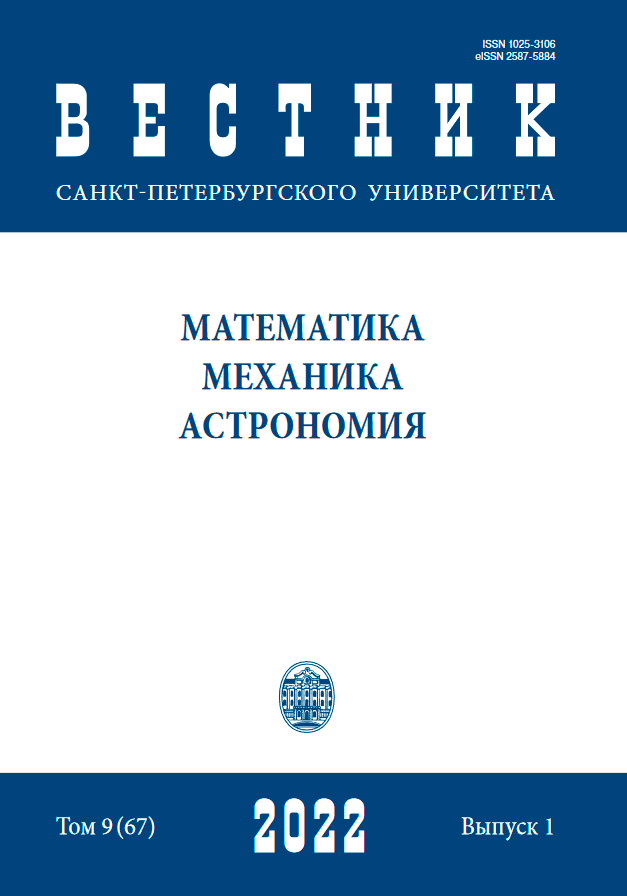Modeling vibrational relaxation rate using machine learning methods
DOI:
https://doi.org/10.21638/spbu01.2022.111Abstract
The aim of the present study is to develop an efficient algorithm for simulating nonequilibrium gas-dynamic problems using the detailed state-to-state approach for vibrationalchemical kinetics. Optimization of the vibrational relaxation rate computation using machine learning algorithms is discussed. Since traditional calculation methods require a large number of operations, time and memory, it is proposed to predict the relaxation rates instead of explicit calculations. K-nearest neighbour and histogram based gradient boosting algorithms are applied. The algorithms were trained on datasets obtained using two classical models for the rate coefficients: the forced harmonic oscillator model and that of Schwartz-Slawsky-Herzfeld. Trained algorithms were used to solve the problem of spatially homogeneous relaxation of the O2-O mixture. Comparison of accuracy and calculation time by different methods is carried out. It is shown that the proposed algorithms allow one to predict the relaxation rates with good accuracy and to solve approximately the set of governing equations for the fluid-dynamic variables. Thus, we can recommend the use of machine learning methods in nonequilibrium gas dynamics coupled with detailed vibrational-chemical kinetics. The ways of further optimization of the considered methods are discussed.Keywords:
nonequilibrium flows, vibrational kinetics, machine learning
Downloads
Download data is not yet available.
References
Литература
1. Нагнибеда Е.А., Кустова Е.В. Кинетическая теория процессов переноса и релаксации в потоках неравновесных реагирующих газов. Санкт-Петербург, Изд-во С.-Петерб. ун-та (2003).
2. Фрадков А.Л. Машинное обучение и искусственный интеллект в работах В.А.Якубовича. Вестник Санкт-Петербургского университета. Математика. Механика. Астрономия 8 (66), вып. 4, 620–624 (2021). https://doi.org/10.21638/spbu01.2021.407
3. Mott A., Job J., Vlimant J.R., Lidar D., Spiropulu M. Solving a Higgs optimization problem with quantum annealing for machine learning. Nature 550, 375–379 (2017). https://doi.org/10.1038/nature24047
4. Koch-Janusz M., Ringel Z. Mutual information, neural networks and the renormalization group. Nature Phys. 14, 578–582 (2018). https://doi.org/10.1038/s41567-018-0081-4
5. Carleo G., Troyer M. Solving the quantum many-body problem with artificial neural networks. Science 335, 602–606 (2017). https://doi.org/10.1126/science.aag2302
6. Istomin V.A., Kustova E.V. PAINeT: Implementation of neural networks for transport coefficients calculation. Journal of Physics: Conference Series 1959 (8), 012024 (2021). https://doi.org/ 10.1088/1742-6596/1959/1/012024
7. Schwartz R., Slawsky Z., Herzfeld K. Calculation of vibrational relaxation times in gases. J. Chem. Phys. 20, 1591 (1952). https://doi.org/10.1063/1.1700221
8. Adamovich I., Macheret S., Rich J., Treanor C. Vibrational energy transfer rates using a forced harmonic oscillator model. J. Thermophys. Heat Transfer 12, 57–65 (1998). https://doi.org/10.2514/2.6302
9. Кунова О.В., Кустова Е.В., Мельник М.Ю., Савельев А.С. Валидация моделей поуров- невой кинетики кислорода за фронтом ударной волны. Физико-химическая кинетика в газовой динамике 19 (3) (2018). http://doi.org/10.33257/PhChGD.19.3.765
10. Python-библиотека scikit-learn. Доступно на: https://scikit-learn.org/ (дата обращения: 01.11.2021).
References
1. Nagnibeda E.A., Kustova E.V. Kineticheskaia teoriia protsessov perenosa i relaksatsii v potokakh neravnovesnykh reagiruiushchikh gazov. St Petersburg, St Petersburg Univ. Press (2009). (In Russian) [Eng. transl.: Nagnibeda E.A., Kustova E.V. Nonequilibrium Reacting Gas Flows. Kinetic Theory of Transport and Relaxation Processes. Berlin, Heidelberg, Springer-Verlag (2009)].
2. Fradkov А. L. Machine learning and artificial intelligence in the works of V.A.Yakubovich. Vestnik of Saint Petersburg University. Mathematics. Mechanics. Astronomy 8 (66), iss. 4, 620–624 (2021). https://doi.org/10.21638/spbu01.2021.407 (In Russian) [Eng. transl.: Vestnik St Petersburg University, Mathematics 54 (4), 381–383 (2021). https://doi.org/10.1134/S1063454121040075].
3. Mott A., Job J., Vlimant J.R., Lidar D., Spiropulu M. Solving a Higgs optimization problem with quantum annealing for machine learning. Nature 550, 375–379 (2017). https://doi.org/10.1038/nature24047
4. Koch-Janusz M., Ringel Z. Mutual information, neural networks and the renormalization group. Nature Phys. 14, 578–582 (2018). https://doi.org/10.1038/s41567-018-0081-4
5. Carleo G., Troyer M. Solving the quantum many-body problem with artificial neural networks. Science 335, 602–606 (2017). https://doi.org/10.1126/science.aag2302
6. Istomin V.A., Kustova E.V. PAINeT: Implementation of neural networks for transport coefficients calculation. Journal of Physics: Conference Series 1959 (8), 012024 (2021). https://doi.org/ 10.1088/1742-6596/1959/1/012024
7. Schwartz R., Slawsky Z., Herzfeld K. Calculation of vibrational relaxation times in gases. J. Chem. Phys. 20, 1591 (1952). https://doi.org/10.1063/1.1700221
8. Adamovich I., Macheret S., Rich J., Treanor C. Vibrational energy transfer rates using a forced harmonic oscillator model. J. Thermophys. Heat Transfer 12, 57–65 (1998). https://doi.org/10.2514/2.6302
9. Kunova O.V., Kustova E.V., Melnik M.Yu., Savelev A. S. Validation of Models of State-to-State Oxygen Kinetics behind Shock Waves. Physical-Chemical Kinetics in Gas Dynamics 19 (3) (2018). http://doi.org/10.33257/PhChGD.19.3.765 (In Russian)
10. Python-library scikit-learn. Available at: https://scikit-learn.org/ (accessed: November 01, 2021).
Downloads
Published
2022-04-11
How to Cite
Bushmakova M. А., & Kustova, E. V. (2022). Modeling vibrational relaxation rate using machine learning methods. Vestnik of Saint Petersburg University. Mathematics. Mechanics. Astronomy, 9(1), 113–125. https://doi.org/10.21638/spbu01.2022.111
Issue
Section
Mechanics
License
Articles of "Vestnik of Saint Petersburg University. Mathematics. Mechanics. Astronomy" are open access distributed under the terms of the License Agreement with Saint Petersburg State University, which permits to the authors unrestricted distribution and self-archiving free of charge.




